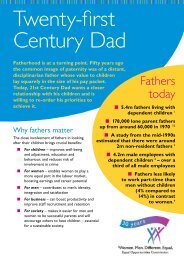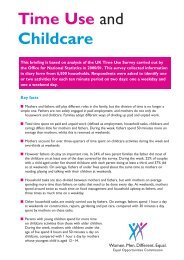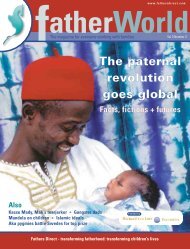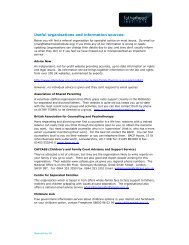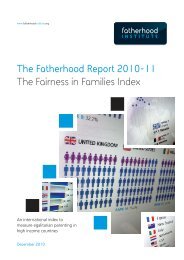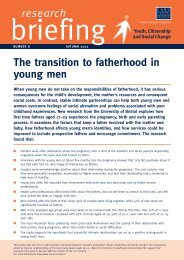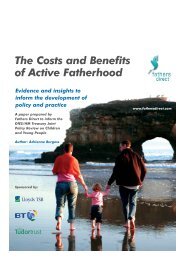EOC Fathers: balancing work and family - The Fatherhood Institute
EOC Fathers: balancing work and family - The Fatherhood Institute
EOC Fathers: balancing work and family - The Fatherhood Institute
You also want an ePaper? Increase the reach of your titles
YUMPU automatically turns print PDFs into web optimized ePapers that Google loves.
RESEARCHfindings<strong>Fathers</strong>:<strong>balancing</strong> <strong>work</strong> <strong>and</strong> <strong>family</strong>Both research <strong>and</strong> policy on <strong>balancing</strong> <strong>work</strong> <strong>and</strong> <strong>family</strong> life have tended to focus onmothers’ lives. As a result, men’s fathering roles have often been neglected. Two <strong>EOC</strong>research studies explore how fathers fulfil their roles both within the <strong>family</strong> <strong>and</strong> at<strong>work</strong> <strong>and</strong> what support could be of most benefit to them in combining these roles.Key Findings■ <strong>The</strong> breadwinning role remains crucial for many fathers. Many also emphasise‘being there’ for their children <strong>and</strong> aspirations for more involved fatherhoodare high.■ Most fathers play a support role within the <strong>family</strong> - they often have minimalinvolvement with their children during the week but put weekends aside for<strong>family</strong> life.■ Some fathers’ support role is extensive. About one-third of active parentalchildcare is already carried out by fathers.■ <strong>The</strong> gap in pay between men’s <strong>and</strong> women’s wages <strong>and</strong> the high cost of childcareare among the factors affecting fathers' level of involvement.■ <strong>Fathers</strong> are more involved in childcare when their partner has a relatively highincome <strong>and</strong> is <strong>work</strong>ing full-time.■ <strong>Fathers</strong> often regard <strong>balancing</strong> <strong>family</strong> <strong>and</strong> <strong>work</strong> as a personal responsibility <strong>and</strong>use informal arrangements with managers.■ <strong>Fathers</strong>’ expectations <strong>and</strong> use of specific <strong>family</strong>-friendly policies <strong>and</strong> practices arelow despite high dem<strong>and</strong> from parents for an improved balance between <strong>work</strong><strong>and</strong> <strong>family</strong>.■ Eight out of ten employers believe that <strong>family</strong>-friendly policies improve therecruitment <strong>and</strong> retention of staff, despite mixed messages on the overallcost benefits.■ <strong>Fathers</strong>’ take-up of parental leave is encouragedby individual entitlement, flexibility betweenpartners, awareness campaigns <strong>and</strong>,crucially, high compensation forlost wages.
<strong>Fathers</strong>: <strong>balancing</strong> <strong>work</strong> <strong>and</strong> <strong>family</strong>Background<strong>The</strong>se findings summarise the key points fromtwo <strong>EOC</strong> reports.■ Working <strong>Fathers</strong>: earning <strong>and</strong> caringreviews recent literature on fathers inemployment, focusing on their ability tobalance <strong>work</strong> with <strong>family</strong> life <strong>and</strong> the rolethey play within the <strong>family</strong>. It also reportson a secondary analysis of the DfEE 2000Work-Life Balance 2000 1 (WLB2000)datasets exploring the provision, dem<strong>and</strong><strong>and</strong> uptake of <strong>family</strong>-friendly employmentpractices among fathers.■ In contrast, Dads on Dads: needs <strong>and</strong>expectations at home <strong>and</strong> at <strong>work</strong> describes aqualitative study which interviewed fathers,their partners <strong>and</strong> human resources staffto explore fathers’ attitudes towards, <strong>and</strong>experiences of, being a <strong>work</strong>ing father. Allquotes from parents are from this study.<strong>Fatherhood</strong><strong>Fathers</strong> are more likely to be economicallyactive <strong>and</strong> in full-time employment than menwithout children. <strong>The</strong> vast majority of fathers<strong>work</strong> full-time (86 per cent). Between 1998<strong>and</strong> 2001 there was a small increase in theproportion of mothers <strong>work</strong>ing full-time(from 29 to 31 per cent) whereas part-time<strong>work</strong>ing remained static. This suggests aperiod of <strong>work</strong> intensification for parents.<strong>The</strong> proportion of lone fathers <strong>and</strong> mothersin full-time employment also increased duringthat period. <strong>The</strong> volume of paid <strong>work</strong>undertaken by fathers remains two-thirdshigher than that undertaken by mothers.<strong>Fathers</strong> are not a homogeneous group <strong>and</strong>there is a wide variety in the roles they adopt.A number of studies emphasise the importanceof the breadwinner role as a powerful sourceof identity for fathers <strong>and</strong> many cite this role astheir main <strong>family</strong> commitment. Studies showthat their earnings are positively associatedwith children’s educational attainment <strong>and</strong>psychological well-being while being a providerfor the <strong>family</strong> gives fathers a clearly definedrole. As one father put it:“Well, the only one [commitment] I cansee is basically keeping them fed, a houseover their heads.”At the same time, comparative studies indicatethat there is a greater acceptance of lesstraditional gender roles in Britain thanelsewhere, strongest in relation to women’sroles. Both reports found that younger men, inparticular, have expressed a wish to participatemore fully in <strong>family</strong> life, <strong>and</strong> there are somefathers for whom the breadwinning role hasless relevance, especially those whose partneris also <strong>work</strong>ing full-time:“Personally I wouldn’t have any hesitationin a kind of stereotypical role reversal ifyou like, where she went out to <strong>work</strong> <strong>and</strong>I looked after the kids…I’m sure they’ddrive me up the wall from time to time aswell, but equally they do with my wife,so I can’t see that as being any different,really I can’t.”So fatherhood is in a state of change. <strong>The</strong>everyday, traditional role of providingeconomic support for the <strong>family</strong> now takesplace alongside activities previously regardedas maternal, so that ‘negotiating tradition <strong>and</strong>change is at the heart of contemporaryfatherhood’.Another aspect of fatherhood is providingpsychological support - ‘being there’ for thechildren. This can mean many different things –physically being around the home as much aspossible given the constraints of <strong>work</strong>, but alsospending ‘quality time’ with the children:“Being available when they need it, beinga good role model, being their mate,empathising with them, facilitating themto develop <strong>and</strong> learn…Being around <strong>and</strong>being part of their lives really.”Studies suggest that the gender of the parentis less important for child development thanbroader parenting style. Early fatherinvolvement with a child is associated withcontinuing involvement with that childthroughout childhood <strong>and</strong> adolescence. Fornon-resident fathers, parenting style is a moreimportant predictor of good child outcomesthan frequency of visits.1 Available from the ESRC Data Archive, University of Essex.2
RESEARCHfindings<strong>Fathers</strong> in the ‘support’ roleIn 2001, fathers <strong>work</strong>ed an average of 46 hoursper week with nearly 40 per cent <strong>work</strong>ing 48hours or more <strong>and</strong> one-eighth 60 or morehours per week. <strong>Fathers</strong> in dual-earnerhouseholds who <strong>work</strong> more than 50 hours perweek lowered their participation in childcare<strong>and</strong> house<strong>work</strong>, while a recent study foundthat fathers who had ‘atypical’ <strong>work</strong>ing patternsin terms of their <strong>work</strong>ing hours, limited <strong>family</strong>activities with children <strong>and</strong> partners.<strong>The</strong> qualitative study suggests that fathers adaptas circumstances change, but that they broadlyfall into one of four main categories (althoughthese are not labels that the fathers usethemselves).■ Enforcer dad is not involved in the day today care of children <strong>and</strong> sees the mostimportant aspects of being a father asproviding a role model <strong>and</strong> clear rules forthe children. <strong>The</strong>se fathers are usually older<strong>and</strong> tend to emphasise traditional sex roles.■ Entertainer dad often entertains thechildren while mother does the household<strong>work</strong> like cooking <strong>and</strong> cleaning, but tendsnot to be involved in those tasks himself.■ Useful dad also entertains the children buthelps out with day to day childcare <strong>and</strong>some household tasks. He still takes thelead from the mother about what needsdoing <strong>and</strong> when.■ Fully-involved dad is as equally involvedwith running the home <strong>and</strong> <strong>family</strong> as hispartner, at least some of the time, <strong>and</strong>parental roles are virtually interchangeable.Most fathers are in the two middle groupswhich implies a support role in the homerather than a sharing of responsibility. Thissupport is often provided mostly at theweekends, when fathers try to compensatefor the long hours they <strong>work</strong> during the weekby dedicating their weekends to <strong>family</strong> life.“I would say he is a bit of a weekend dad.I mean, he is fantastic at the weekends,he is great…but during the week he isnever here…so he probably spends lessthan five minutes with them during theweek, per day.”American research findings are similar,showing that the largest proportion of fathertime is spent on play <strong>and</strong> companionshipactivities. Weekends are emerging as specialtimes for many <strong>work</strong>ing families, providingopportunities for parents <strong>and</strong> children tosustain <strong>family</strong> relationships, often in the faceof increasing <strong>work</strong>ing hours.A number of studies show that since the1970s, there has been an upward trend infathers’ <strong>and</strong> mothers’ involvement in childcare.This has been particularly sharp for fatherswith children under the age of five years who,in the mid-1970s devoted less than a quarterof an hour per day to child-related activities(as their main activity), in contrast to twohours a day by the late 1990s. Overall, timespent by fathers accounts for one-third of alltotal parental childcare time.<strong>Fathers</strong>’ time spent on child-related activity (where this is the main activity)120■minutes per day100806040200■◆▲■▲◆1961 1974/5 1984/7 1999■◆ ▲◆▲◆■▲all fathersfathers ofchild
<strong>Fathers</strong>: <strong>balancing</strong> <strong>work</strong> <strong>and</strong> <strong>family</strong>Men taking the support roleStructural issuesMen generally earn more than women. <strong>The</strong>current gender pay gap i.e. the averagedifference between men’s <strong>and</strong> women’s fulltimehourly wages, is 18 per cent. Betweenmen <strong>work</strong>ing full-time <strong>and</strong> women <strong>work</strong>ingpart-time it is 41 per cent. So where the fatherearns more than the mother (as is generallythe case) it is a pragmatic <strong>family</strong> decision forthe father to continue to <strong>work</strong> full-time <strong>and</strong>for the mother to take on more of thedomestic burden, possibly reducing her<strong>work</strong>ing hours.Directly linked to this is the availability <strong>and</strong> highcost of childcare. As a result, mothers’ <strong>work</strong>patterns <strong>and</strong> prospects often changeconsiderably after the birth of a child:“It has affected my career enormouslyactually, <strong>and</strong> it hasn’t affected Tim’s at all.”<strong>The</strong> link between the relative pay of women<strong>and</strong> men <strong>and</strong> the division of caring roles isalso emphasised by the fact that the mostegalitarian sharing of household <strong>and</strong> childcaretasks tends to be found in dual-earnerhouseholds where the mother earns morethan her partner. In these cases, the father ismore involved in <strong>family</strong> life, both in terms ofchildcare <strong>and</strong> routine household <strong>work</strong>, “Abargaining type of interpretation: that it maynot be just having to <strong>work</strong> that warrantsincreased care giving from father, but themonetary value of that <strong>work</strong>”. 2Similarly, fathers who are involved in theemotional side of parenting – having privatetalks with children, helping with home<strong>work</strong>etc., are more likely to be involved in routinehousehold tasks compared with those whoseinvolvement stops at leisure <strong>and</strong> entertainment.Expectations<strong>The</strong> attention given to fathers in nationalpolicies can indicate the importance whichsociety places on fathers’ care of children <strong>and</strong>their role within the <strong>family</strong>. <strong>The</strong> broadeningof policy initiatives on fatherhood has been adistinctive feature of the latter part of Labour’sterm of office. This has brought Britain more inline with its European partners.Yet it is still generally accepted that womenwill take time off, <strong>work</strong> part-time or job sharein order to look after their children. It istaken for granted that a mother will alter her<strong>work</strong>ing pattern or face the double pressure ofa <strong>work</strong> <strong>and</strong> a <strong>family</strong> career, whereas the fatherwill only have his <strong>work</strong> career to contend with.For example, schools tend to ring the motherinitially, not the father, when a child is sick:“<strong>The</strong>re is a cultural acceptance thatmothers will have the first call…”In addition, some fathers show a lack ofenthusiasm for staying at home more, suggestingthat they would find it hard but mundane <strong>work</strong>.<strong>The</strong>re is little reflection that this is also thesame for mothers, sometimes falling back ontraditional, gender role explanations:“I think possibly the mother is moresuited…but probably again with thetraditional root of things maybe themother is better equipped all round atbeing with the child.”In some cases, fathers who are prevented by<strong>work</strong> commitments from spending more timewith their families do admit that this is a choicethey have made, <strong>and</strong> that they are perhapslacking the motivation to be further involved.<strong>Fathers</strong> may also feel less confident or capablethan their partner at looking after the children.Men in the case studies suggest that thereshould be courses for new fathers to preparethem for having children, involving childcareskills as well as time management.Workplace cultureDuring the 1990s there was increasedawareness amongst employers of quality oflife issues plus concerns about staff retention,stress-induced absenteeism <strong>and</strong> business costsin general. A lack of balance between <strong>work</strong><strong>and</strong> <strong>family</strong> life is recognised as a major factorin occupational stress.2 Fuligini, A.S. <strong>and</strong> Brooks-Gunn, J. (2001) Measuring mother <strong>and</strong> father shared caregiving: An analysis using the panel study of income dynamics -child development supplement. Paper presented at the “Workshop on Measuring Father Involvement” February 8-9, 2001, Bethesda, Maryl<strong>and</strong>.4
RESEARCHfindings<strong>The</strong> <strong>work</strong>place culture can have a huge impactupon a father’s ability to balance his <strong>work</strong> <strong>and</strong><strong>family</strong> responsibilities. This is about more thanjust <strong>family</strong>-friendly policies. It includes issuessuch as how comfortable fathers feel discussingtheir <strong>family</strong> commitments in the <strong>work</strong>place <strong>and</strong>how acceptable it is to leave early in order topick up the children from school, or to spendtime with them in the evenings:“... even though they might have thepolicies in writing about how they are<strong>family</strong>-friendly, you wonder sometimeswhat their attitude would be like if youhad a lot of needs <strong>and</strong> you had to be reallyflexible <strong>and</strong> in <strong>and</strong> out all the time.”<strong>The</strong>re is a general attitude that long hoursdemonstrate commitment to an organisation,yet there is a clear relationship betweenlong <strong>work</strong>ing hours <strong>and</strong> levels of <strong>work</strong>dissatisfaction, unhappiness about hours <strong>and</strong>general discontent about the extent to which<strong>work</strong> <strong>and</strong> non-<strong>work</strong> interests can be balanced.Over 80 per cent of fathers in the WLB2000survey were fairly or very satisfied with their<strong>work</strong>ing hours, but this dropped to 60 per centfor those <strong>work</strong>ing 48+ hours per week <strong>and</strong> to50 per cent for those regularly <strong>work</strong>ing 60+hours. Some fathers feel that they are activelystruggling against the culture of long hours <strong>and</strong>that there is a constant tension:“If employers want to have a long hoursculture, I don’t see how they can reconcilebeing <strong>family</strong>-friendly employers at thesame time.”“We need to stop making <strong>work</strong> the focusof our lives. I think men are particularlyvictim to the long hours culture.”Part-time <strong>work</strong> for fathers is generally notseen as an option. Not only are the financialaspects prohibitive, but it is widely felt thatpart-time <strong>work</strong> does not have the same statusas full-time employment <strong>and</strong> that, in someway, it suggests a reduced commitment to theemploying organisation. <strong>The</strong> quality of fathers’<strong>work</strong> can also have an effect on <strong>family</strong> life, withthe effects of <strong>work</strong> overload sometimes beingmore severe than those of long hours.Balancing responsibilities at home<strong>and</strong> at <strong>work</strong>Eighty per cent of fathers <strong>and</strong> 85 per cent ofmothers agreed that employees should beable to balance their <strong>work</strong> <strong>and</strong> home lives asthey want, compared with 62 per cent ofemployers. This shows encouraging levels of‘commitment in principle’ by employersalthough there remains a substantial gapbetween this <strong>and</strong> the high degree ofexpectation of provision by parents.Although 90 per cent of companies reportedthat there was one or more ‘proactivemechanism’ in place to inform staff about whatwas available, the most common form ofcommunication, reported by over a quarter ofemployers, was word of mouth. This suggeststhat on an individual company level, manyemployers rely on unsystematic <strong>and</strong> informalinformation flows to promote awareness ofpolicies. As a result, many employees areunaware of such policies in their <strong>work</strong>place.It is also possible that some companies activelychoose not to promote their <strong>family</strong> friendlypolicies:“I think, being truthful, we would notgo out of our way to publicise it.”Some companies argue that there is noobvious dem<strong>and</strong> from fathers. But fathers maynot know that the policies exist. Even wherethey do exist, fathers are often happier relyingon informal arrangements, or assume that thepolicies are either not relevant to them, or arenot aimed at the main breadwinner. In the casestudy research, fathers sometimes tended toview the need to resolve their <strong>work</strong> <strong>and</strong> <strong>family</strong>roles as a personal responsibility:“I do think far more is to do with yourown considerations about the <strong>work</strong>-lifebalance, <strong>and</strong> if you really want to havemore input in things at home then youhave to do it yourself.”So fathers’ expectations about whether specific<strong>work</strong>-life balance practices could be madeavailable in their current <strong>work</strong>place are low, asis their access to <strong>family</strong>-sensitive facilities suchas subsidised or <strong>work</strong>place nurseries or otherfinancial help with childcare. Indeed, a majority5
<strong>Fathers</strong>: <strong>balancing</strong> <strong>work</strong> <strong>and</strong> <strong>family</strong>Expectations of access to <strong>and</strong> provision of flexible <strong>work</strong>ing time arrangementsReduced hoursAnnualised hoursCompressed weekFlexitimeJob shareTerm-time onlyPart-time <strong>work</strong>ing■■■fathersmothersemployers0 20 40 60 80 100per centSource: Work-Life Balance 2000 Employee survey, IFER/IFF, 2000. Available from ESRC Data Archive, University of Essex.of fathers said that they were satisfied withtheir overall job, the hours they <strong>work</strong>ed <strong>and</strong>their flexibility over <strong>work</strong>ing hours.Use of existing policies<strong>Fathers</strong> actual use of flexible <strong>work</strong>ing practicesis low, with shift <strong>work</strong> <strong>and</strong> flexitime the mostprevalent. In general, fathers were most likelyto want access to flexitime, a compressed<strong>work</strong>ing week or the ability to <strong>work</strong> at home.Those who were dissatisfied with their<strong>work</strong>ing hours highlighted three favouredchanges: being able to leave on time; <strong>work</strong>ingless overtime; <strong>and</strong> <strong>work</strong>ing more hours formore pay.Many new fathers have made use of paternityleave: 61 per cent of fathers with a childunder one year in the WLB2000 survey.This provides a good baseline figure for theintroduction of the Government’s policy oftwo weeks statutory paternity leave, whichcomes into effect in April 2003.Informal arrangementsFor many fathers, informal agreements madewith their manager were felt to be sufficientto meet their needs. In the case studies,employees <strong>work</strong>ing in a small business saidthere was ad hoc flexibility when necessary.It was possible to change shifts for <strong>family</strong>reasons on occasion, but generally not toshorten <strong>work</strong>ing hours. This also applied inemergencies.Similarly, informal arrangements werepreferred by the public sector employees inthe case studies, even though the organisationhad formal policies in place to help parents.Employees were happy to negotiate time offwith their manager <strong>and</strong> did not tend to makeuse of the actual policies, although it is likelythat the very fact that the policies existedhelped them to negotiate this flexibility.However, managers were not alwaysunderst<strong>and</strong>ing of fathers’ <strong>family</strong> commitments<strong>and</strong> some fathers would have preferredgreater flexibility:“I asked for a couple of hours in themorning because my boy was startingschool that morning. I asked him the daybefore <strong>and</strong> he said “no, can’t you go thenext day”…<strong>and</strong> that comes from a malethat didn’t have children.”Encouraging take-up<strong>The</strong> early 1970s saw the beginnings of fathersensitive<strong>family</strong> policies in Europe. Paternityleave, which marked the arrival of a legal rightthat fathers should be absent from <strong>work</strong> for aperiod of time when their child is born, wasfirst introduced in Sweden in 1974. <strong>The</strong>philosophy behind the Swedish <strong>and</strong> much ofthe Nordic parental support policies has beenfrom an equal opportunities perspective –to create a social environment where women<strong>and</strong> men have the same access toemployment, familial <strong>and</strong> personal fulfilment.6
RESEARCHfindingsUse of flexible <strong>work</strong>ing time arrangementsWorking from homePart-time <strong>work</strong>FlexitimeCompressed weekAnnualised hoursShift <strong>work</strong>Term-time onlyJob share■■fathersmothers0 20 40 60per centSource: Work-Life Balance 2000 Employee survey, IFER/IFF, 2000. Available from ESRC Data Archive, University of Essex.European experience shows that whenparental leave entitlement is available to eitherthe man or the women, it is taken by veryfew men – less than five per cent. One way ofimproving father take-up is to have designated‘daddy periods’, where a proportion of paidparental leave is set aside exclusively forfathers. In Norway, four weeks of parentalleave is available only to fathers <strong>and</strong> use ofthis special father’s quota rose to 85 per centin 2000. This policy recognises the needs ofboth mothers <strong>and</strong> fathers – as the quota wasan extension of parental leave <strong>and</strong> notsubtracted from maternal leave.Sc<strong>and</strong>inavian experience suggests that hightake-up of parental leave by fathers is linkedto four key conditions: when parental leaveis an individual entitlement not transferablebetween the mother <strong>and</strong> father; where thereis flexibility in the way that leave can be usedby couples; when provision for fathers ispublicised through Government awarenesscampaigns; <strong>and</strong> where there is high wagecompensation.Given this, the probable take-up of unpaidparental leave in Britain is likely to be verylimited, although it is broadly welcomed as astep in the right direction. <strong>The</strong> case studyresearch confirmed concerns that the levelof reimbursement at £100 per week forpaternity leave will not be sufficient,particularly at a time when <strong>family</strong> costs havesuddenly increased. Evidence from the Nordiccountries suggests that income replacementlevels of 80-100 per cent of earnings are anecessary condition for universal take-up.<strong>The</strong> business case<strong>The</strong> WLB2000 survey found that a majorityof employers felt that the impact of <strong>family</strong>sensitivepractices <strong>and</strong> policies on theorganisation was positive. Eight out of tenemployers thought that they fostered goodemployment relations <strong>and</strong> two-thirds agreedthat they improved staff motivation, retention<strong>and</strong> turnover. However, 44 per cent thoughtthat they increased overall costs to business.European evidence is also somewhat mixed,with some surveys showing that parentalleave schemes, for example, have causedproblems for their organisations.Implications from the research<strong>Fatherhood</strong> is in a state of change. It is clearfrom the two studies that fathers are alreadymore centrally involved in <strong>family</strong> life, even ifthis is often in a support role to the mother.An informed public debate is needed abouthow fathers balance their economic <strong>and</strong> othercommitments to children <strong>and</strong> partners. <strong>The</strong>introduction of paternity leave could act as acatalyst for such a debate.A change in <strong>work</strong>place culture is needed sothat active fatherhood is accepted <strong>and</strong> the7
<strong>Fathers</strong>: <strong>balancing</strong> <strong>work</strong> <strong>and</strong> <strong>family</strong>prevalence of long <strong>work</strong>ing hours reduced.Excessive <strong>work</strong>ing hours reduce satisfactionwith <strong>work</strong>-<strong>family</strong> balance <strong>and</strong> fathers’involvement with children.<strong>The</strong> new flat-rate paid paternity leave <strong>and</strong>unpaid parental leave schemes will both needcareful monitoring to assess satisfaction <strong>and</strong>uptake. <strong>The</strong> research suggests that manyfathers in Britain will not even consider takingparental leave that is unpaid <strong>and</strong> the Nordicexperience of parental leave schemes showthat uptake is greater where incomereplacement levels are high <strong>and</strong> a specialdedicated ‘daddy quota’ is adopted.Employers need to promote policies whichare available <strong>and</strong> ensure that fathers knowwhich practices are relevant to them. <strong>The</strong>research shows that fathers need moreflexibility in the <strong>work</strong>place, with greatercontrol over their <strong>work</strong>ing day.Addressing the gender pay gap is key toenabling greater choice about the roles thatwomen <strong>and</strong> men play in the home. Mencurrently earn more than women on average,which encourages the traditional gender rolesof father as breadwinner <strong>and</strong> mother as carer.<strong>Fathers</strong> are more willing to alter their <strong>work</strong>paterns if their partner earns more thanthemselves.It is important that any policies <strong>and</strong> practiceswhich are introduced to help parents balancetheir <strong>work</strong> <strong>and</strong> <strong>family</strong> roles, recognise thediffering needs of both mothers <strong>and</strong> fathers.Technical Note<strong>The</strong> WLB2000 Employee survey datasetcomprises data from a nationally representativesurvey of 7,500 persons in employment in<strong>work</strong>places with five or more staff, including1,486 fathers <strong>and</strong> 2,260 mothers withdependent children. <strong>The</strong> Employer datasetcomprises data from a nationally representativesurvey of 2,500 <strong>work</strong>places with five or moreemployees. MORI conducted 61 qualitativein-depth interviews with fathers, theirpartners <strong>and</strong> HR managers in six case studyorganisations, <strong>and</strong> three focus groups withfathers, between April <strong>and</strong> June 2002.Working <strong>Fathers</strong>: earning <strong>and</strong> caringby Margaret O'Brien <strong>and</strong> Ian Shemilt,University of East Anglia (January 2003)<strong>and</strong> Dads on Dads: needs <strong>and</strong>expectations at home <strong>and</strong> at <strong>work</strong> byWarren Hatter, Louise Vinter <strong>and</strong> RachelWilliams, MORI Social Research <strong>Institute</strong>(October 2002) are published in the <strong>EOC</strong>Research Discussion series. <strong>The</strong>y can bedownloaded from the <strong>EOC</strong> website orare available as hard copy.For further information about <strong>EOC</strong>research <strong>and</strong> statistical <strong>work</strong>:web: www.eoc.org.uk/researchemail: research@eoc.org.uktel: 0161 838 8340© <strong>EOC</strong> March 2003 ISBN 1 84206 046 5RESEARCHfindingsGreat Britain Wales Scotl<strong>and</strong>Arndale House Windsor House St. Stephens HouseArndale Centre Windsor Lane 279 Bath StreetManchester Cardiff GlasgowM4 3EQ CF10 3GE G2 4JL8



